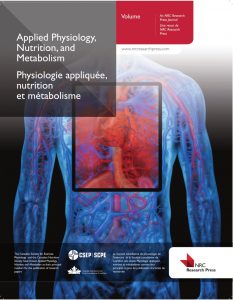Publications

The effects of compression garments on performance of prolonged manual-labour exercise and recovery
Authors: Val Chan, Rob Duffield, Mark Watsford
Affiliations: Sport and Exercise Discipline Group, Faculty of Health, University of Technology Sydney, Lindfield, Australia
Journal: Nutrition and Metabolism - January 2016, Volume 41, Issue 2, Pages 125-132 (DOI: 10.1139/apnm-2015-0335)
-
Field & Applications:
- Medical
- Occupational Healthcare
This study investigated the effects of wearing compression garments during and 24 h following a 4-h exercise protocol simulating manual-labour tasks. Ten physically trained male participants, familiar with labouring activities, undertook 4 h of work tasks characteristic of industrial workplaces. Participants completed 2 testing sessions, separated by at least 1 week. In the experimental condition, participants wore a full-length compression top and compression shorts during the exercise protocol and overnight recovery, with normal work clothes worn in the control condition. Testing for serum creatine kinase and C-reactive protein, handgrip strength, knee flexion and extension torque, muscle stiffness, perceived muscle soreness and fatigue as well as heart rate and rating of perceived exertion (RPE) responses to 4-min cycling were performed before, following, and 24 h after exercise. Creatine kinase, muscle soreness, and rating of perceived fatigue increased following the exercise protocol (p < 0.05) as did RPE to a standardised cycling warm-up bout. Conversely, no postexercise changes were observed in C-reactive protein, handgrip strength, peak knee flexion torque, or stiffness measures (p > 0.05). Knee extension torque was significantly higher in the control condition at 24 h postexercise (3.1% ± 5.4% change; compression: 2.2% ± 11.1% change), although no other variables were different between conditions at any time. However, compression demonstrated a moderate–large effect (d > 0.60) to reduce perceived muscle soreness, fatigue, and RPE from standardised warm-up at 24 h postexercise. The current findings suggest that compression may assist in perceptual recovery from manual-labour exercise with implications for the ability to perform subsequent work bouts.
Keywords: Industrial work, Workability, Muscle soreness, Exercise recovery, Occupational fatigue.
Compression garments had minimal influence on performance or recovery from a 4-h manual-labour exercise protocol. Although there were no differences in strength or physiological parameters, compression garments appeared to have a positive moderate– large effect on perceptual measures in the recovery period following the exercise protocol, though this effect was not statistically significant. Despite the possibility of a placebo effect, use of compression was effective in reducing levels of perceived muscle soreness, perceptual fatigue, and ratings of perceived exertion during subsequent exercise workloads. These outcomes may benefit manual-labour workers in improving their work readiness by decreasing perceived fatigue and perception of physical work and muscle soreness.


